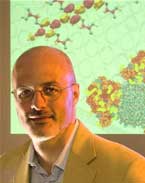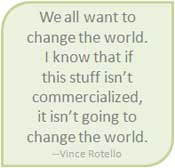
Professor Rotello has published 27 articles this year alone in journals such as Advanced Materials, Langmuir, and Nano Letters that explore the management of templated nanoparticle self-assembly, the controlled manipulation of proteins and microstructures with nanoparticles, and the role of nanoparticles in targeted drug delivery.
Although key challenges still remain in exploiting the properties of nanoparticles and other structures at the nanoscale (rods, wires, tubes, coils, etc.), the challenge for Rotello is “getting nanoparticles to play nicely with the outside environment where they interact with everything else as this is the area where we can make the biggest contribution at this stage.”

Rotello’s research approaches combine top down fabrication processes (electron beam, nano imprint lithographic patterning) with bottom up processes (self assembly, surface functionalization) to achieve his desired result—precisely ordered arrays of nanostructures by design.
The ability to control nanostructures potentially offers new methodologies for designing the properties of the nanostructure into larger device structures. While this is largely “hypothesis-driven research,” moments of true discovery will chart new and interesting ways forward. “Something completely unexpected occurs about once a month,” says Rotello. “The key is to differentiate between what is irreproducible and boring versus what’s unexpected and really exciting and requires further investigation.”
The assembly methods demonstrated by Rotello will impact microelectronics and computing, biosensors, microfluidics, and energy conversion technologies. Substantial interest has already been generated by industry to transition the technology for specified needs in manufacturing. Still, at this stage the development of viable applications is frequently interrupted by “the unfortunate reality of the very short timeline that we have right now bringing things to market,” notes Rotello.
In this respect, Rotello sees startup companies as one of two “essentials” to moving forward with commercialization. “Startups are the ones that can take an idea, if they can get the venture capital for it, they can pursue that idea for a few years and either make it succeed or not.” The other? “For academics, industry, and funding agencies to come up with more creative ways of trying to bridge that gap between the academic time frame and the industrial time frame.”
Beyond transferable methodologies, Rotello’s area of research holds at least one additional key to realizing the broader impact of nanomaterials and technology on society. Scaling and arranging nanoparticles in precise fashion is necessary to study the properties of the nanoparticles as a collective ensemble, something which has been cited as one of the predominant challenges to realizing the full benefits of nanotechnology enabled products. Rotello’s research group seems to have unique perspective on these challenges, while continuing to report progress at a steady pace. “In essence we are marching around the research landscape in this area, trying to avoid coming up against a wall, and seeking directions to move forward.”
More about the Rotello Research Group.
2008 Covers:
 |
 |
 |
 |
 |
| RSC images reproduced by permission of the authors and The Royal Society of Chemistry from Yuval Ofir, Bappaditya Samanta and Vincent M. Rotello, Chem. Soc. Rev., 2008, 37, 1814-1825, DOI:10.1039/b712689c; Mrinmoy De and Vincent M. Rotello, Chem. Commun., 2008, 3504-3506, DOI:10.1039/b805242e; Halil Bayraktar, Sudhanshu Srivastava, Chang-Cheng You, Vincent M. Rotello and Michael J. Knapp, Soft Matter, 2008, 4, 751-756, DOI:10.1039/b716386j; and from Bappaditya Samanta, Haoheng Yan, Nicholas O. Fischer, Jing Shi, D. Joseph Jerry and Vincent M. Rotello, J. Mater. Chem., 2008, 18, 1204, DOI:10.1039/b718745a. Advanced Materials Cover Copyright Wiley-VCH Verlag GmbH & Co. KGaA. Ofir, Y., et al. Polyelectrolyte Negative Resist Patterns as Templates for the Electrostatic Assembly of Nanoparticles and Electroless Deposition of Metallic Films. Advanced Materials 2008 20 2561-2566. Reproduced with permission. | ||||
This work is licensed under a Creative Commons Attribution-NonCommercial-NoDerivs 3.0 Unported.
